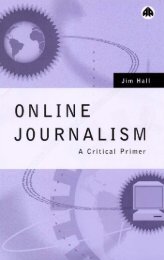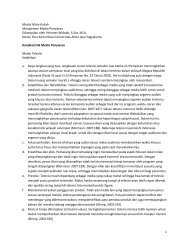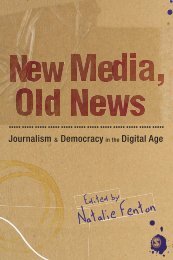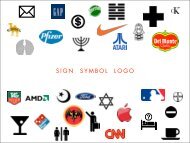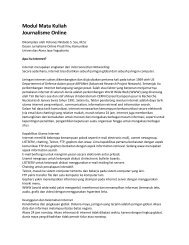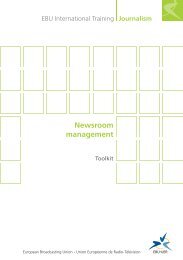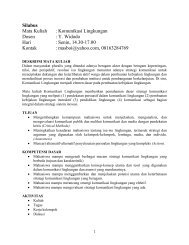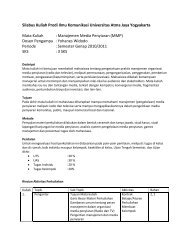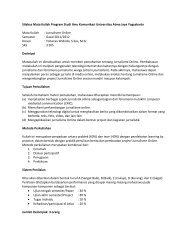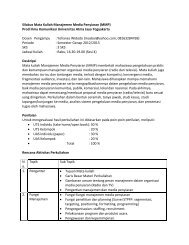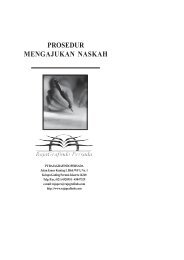1What is online journalism? - Ayo Menulis FISIP UAJY
1What is online journalism? - Ayo Menulis FISIP UAJY
1What is online journalism? - Ayo Menulis FISIP UAJY
Create successful ePaper yourself
Turn your PDF publications into a flip-book with our unique Google optimized e-Paper software.
Design your web resource 165<br />
usually conc<strong>is</strong>e text – <strong>is</strong> king. Navigation <strong>is</strong> ‘a necessary evil’ and<br />
graphics should be kept to a minimum. A favourite Nielsen<br />
aphor<strong>is</strong>m <strong>is</strong> ‘Remove graphic; increase traffic. It’s that simple.’ He<br />
has even argued for the ‘end of web design’, claiming that sites must<br />
‘tone down their individual appearance and d<strong>is</strong>tinct design’. Can’t<br />
be much clearer than that. So he gets put in the blue corner.<br />
In the red corner, you might find someone like David Siegel. 1<br />
Just the title of h<strong>is</strong> best-known book, Creating Killer Web Sites<br />
(1997), gives you an inkling that he doesn’t live on the same block<br />
as Jakob Nielsen.<br />
Then you read the preface, which prom<strong>is</strong>es ‘a thrilling jeepdrive<br />
through the Style Sheet landscape, with pitfalls, pinnacles<br />
and perilous browser implications around every corner’, and you<br />
question whether in fact he lives on the same planet as Nielsen.<br />
Are these two people really talking about the same thing? Well,<br />
in essence, they are, but from very different perspectives.<br />
However, there <strong>is</strong> also some common ground.<br />
You might guess that the following quote comes from Siegel:<br />
‘the scientific method can only take you so far. There <strong>is</strong> still a need<br />
for inspiration and creativity in design.’ In fact, it comes from<br />
Nielsen.<br />
Again, you might guess who said: ‘It <strong>is</strong> the designer’s<br />
responsibility to present content appropriately’ It was actually<br />
David Siegel, between jeep rides.<br />
I’m being selective with my quotes, not to propose a rev<strong>is</strong>ion<strong>is</strong>t<br />
perspective on Nielsen and Siegel but instead to make a<br />
much simpler point. It’s not helpful to sanctify or demonize<br />
either of them. It’s too easy to portray the usability experts as<br />
1 There have been reports that Siegel has had a ‘change of heart’ over h<strong>is</strong> design<br />
beliefs. Lighthouse on the web (www.shorewalker.com/pages/siegel_turns–<br />
1.htm) even went so far as to announce that he had ‘joined the Nielsen camp’,<br />
d<strong>is</strong>illusioned by problems with browser technology. If so, he has not taken any of<br />
h<strong>is</strong> original sites down, and h<strong>is</strong> book Creating Killer Web Sites still sells in large<br />
numbers and continues to provoke debate. Reviews among Amazon readers in<br />
mid-2000 either hailed Siegel’s book as ‘h<strong>is</strong>torically important’ and ‘still cutting<br />
edge after all these years’ or ‘d<strong>is</strong>appointing’ and ‘outdated’. The point <strong>is</strong> that<br />
Siegel’s original concepts, whether he w<strong>is</strong>hes them to be or not, are still<br />
influential and represent a ‘Siegel’ school of thinking as expounded in th<strong>is</strong><br />
chapter.




